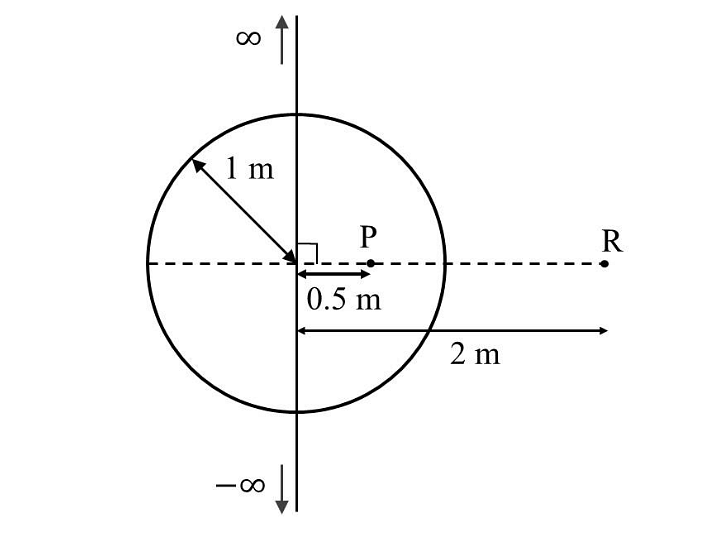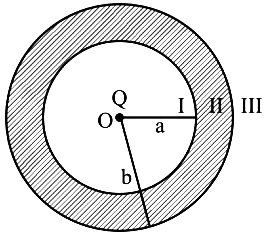A regular hexagon of side 10 cm has a charge 5 μC at each of its vertices. Calculate the potential at the centre of the hexagon.
Solution and Explanation
The given figure shows six equal amount of charges, q, at the vertices of a regular hexagon.

Where,
Charge, q = 5 µC = 5 × 10−6 C
Side of the hexagon, l = AB = BC = CD = DE = EF = FA = 10 cm
Distance of each vertex from centre O, d = 10 cm
Electric potential at point O, \(v=\frac{1}{4πe_0}.\frac{6xq}{d}\)
Where,
Where, = Permittivity of free space and \(\frac{1}{4pi_0}\)= 9 ×10-9 Nm2 c-2
\(v=\frac{9x10^9x6x5x10^-6}{0.1}=2.7x10^6V\)
Therefore, the potential at the centre of the hexagon is 2.7 × 106 V
Top Questions on electrostatic potential and capacitance
- An infinitely long thin wire, having a uniform charge density per unit length of \(5 nC/m,\) is passing through a spherical shell of radius \(1 m\), as shown in the figure. A \(10 nC\) charge is distributed uniformly over the spherical shell. If the configuration of the charges remains static, the magnitude of the potential difference between points P and R, in Volt, is ______. [Given: In SI units \(\frac{1}{ 4πϵ0} = 9 × 10^9 , ln \ 2 = 0.7\). Ignore the area pierced by the wire.]

- JEE Advanced - 2024
- Physics
- electrostatic potential and capacitance
- A charge Q=\(10^{-6}\) C is placed at origin. Find the potential difference between two points A and B whose position vectors are \((V_3î + V_3ĵ)\) m and \(v_6ĵ \) respectively \(î\)
- JEE Main - 2024
- Physics
- electrostatic potential and capacitance
- An electric dipole is placed as shown in the figure.

- NEET (UG) - 2023
- Physics
- electrostatic potential and capacitance
- As shown in the figure, a point charge $Q$ is placed at the centre of conducting spherical shell of inner radius $a$ and outer radius $b$. The electric field due to charge $Q$ in three different regions I, II and III is given by: (I: r $<$ a, II: $a $<$ r $<$ b$, III: $r$>$b)$

- JEE Main - 2023
- Physics
- electrostatic potential and capacitance
- Potential at the surface of a uniformly charged non-conducting sphere is V. Then the potential at its centre is
- JEE Main - 2023
- Physics
- electrostatic potential and capacitance
Questions Asked in CBSE CLASS XII exam
- Find the inverse of each of the matrices,if it exists \(\begin{bmatrix} 2 & 1 \\ 7 & 4 \end{bmatrix}\)
- For what values of x,\(\begin{bmatrix} 1 & 2 & 1 \end{bmatrix}\)\(\begin{bmatrix} 1 & 2 & 0\\ 2 & 0 & 1 \\1&0&2 \end{bmatrix}\)\(\begin{bmatrix} 0 \\2\\x\end{bmatrix}\)=O?
What is the Planning Process?
- CBSE CLASS XII - 2023
- Planning process steps
- Find the inverse of each of the matrices,if it exists. \(\begin{bmatrix} 2 & 3\\ 5 & 7 \end{bmatrix}\)
- Find the inverse of each of the matrices, if it exists. \(\begin{bmatrix} 1 & 3\\ 2 & 7\end{bmatrix}\)
Concepts Used:
Electrostatic Potential and Capacitance
Electrostatic Potential
The potential of a point is defined as the work done per unit charge that results in bringing a charge from infinity to a certain point.
Some major things that we should know about electric potential:
- They are denoted by V and are a scalar quantity.
- It is measured in volts.
Capacitance
The ability of a capacitor of holding the energy in form of an electric charge is defined as capacitance. Similarly, we can also say that capacitance is the storing ability of capacitors, and the unit in which they are measured is “farads”.
Read More: Electrostatic Potential and Capacitance
The capacitor is in Series and in Parallel as defined below;
In Series
Both the Capacitors C1 and C2 can easily get connected in series. When the capacitors are connected in series then the total capacitance that is Ctotal is less than any one of the capacitor’s capacitance.
In Parallel
Both Capacitor C1 and C2 are connected in parallel. When the capacitors are connected parallelly then the total capacitance that is Ctotal is any one of the capacitor’s capacitance.



